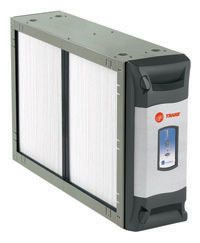
Pompano Beach, FL, December 2011 – The Environmental Protection Agency’s indoor air quality report lists air quality as one of the top five environmental health risks because the air inside homes and businesses is two to five times more polluted than the air outdoors. Since most people spend up to 90% of their time indoors, especially during summer months, Joe Canosa, General Manager of Lindstrom Air Conditioning, a locally owned and operated business since 1975, wants everyone to be aware of how to reduce the particles, pollutants, and allergens that can cause respiratory problems and aggravate allergies.
The average person breathes in about 1,120,000,000 particles every day, including dust, molds, viruses, bacteria, and dander. The smallest of these are called respirable particles because they can be inhaled and lodge in the lungs, aggravating respiratory illnesses and allergies.
The single best way to improve indoor air is to ventilate with clean air from outdoors. “But that’s not always possible, especially during the hottest months,” states Canosa. “When you can’t open the windows, you have to rely on other methods of improving the air, including air purifiers and cleaners, upgraded air filters, and duct cleaning.”
Air purifiers take air filtration to the top level. Canosa suggest an air purifier manufactured by Carrier. “For your money, the best whole-house air purifier on the market is the Carrier Infinity and Performance air cleaner, which is 10 times as effective as a HEPA filter. Its performance has been verified by the experts at the Harvard School of Public Health.” For someone with allergies or respiratory issues, the initial cost of an air purifier is justified by the fact that it will remove about 99.98% of allergens from the air, up to 100 times as many particles as a standard air filter.
Air cleaners are slightly different than air purifiers. Instead of just filtering and trapping allergens, a PHI (photohydroionization) cell radiates oxidizers into the air that are harmless to humans and animals, but deadly to viruses, mold, bacteria, and odors. The PHI cell is installed in your duct work and will eliminate 98% of these harmful particulates. Canosa states, “The gold standard PHI cell is manufactured by RGF Environmental Group. It’s the one I recommend to our clients.”
Ducts can contain dirt, mold, and mites, among other particles. Clean ducts improve indoor air by removing these pollutants at the source, before they are recirculated. Respiratory diseases such as asthma and allergies can be alleviated by the removal of these triggers. Ducts that have been cleaned and sanitized can even remove unpleasant odors, leaving your home smelling cleaner. Although ducts may not necessarily need to be cleaned every year, you should still have them inspected by a professional annually to ensure there are no nasty surprises lurking in them.
Air filters come in many styles and levels of effectiveness. Pleated air filters are the most popular type of air filter for home use. Look for a filter with a MERV of around 11, which will capture about 90% of large particles that it comes into contact with; the MERV rating is more important than a brand name. “But remember, even the best filter will be ineffective if you don’t change it monthly,” cautions Canosa.
Air quality is an issue that affects everyone. A high-efficiency air filter is a good first line of defense against indoor air pollution. Additional steps should include air cleaners and purifiers, humidity control, and duct cleaning, especially for those homes with very young children, the elderly, or who face respiratory illness or allergies. If you are concerned with the quality of air in your home, contact a professional for an analysis of your needs.
To learn more about Lindstrom, visit www.lindstromair.com.
To learn more about RGF Environmental Group, visit http://rgfairpurification.com/index.html.


